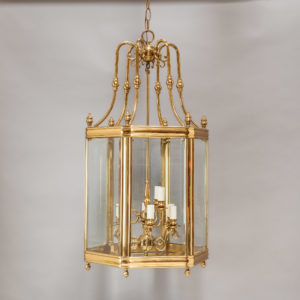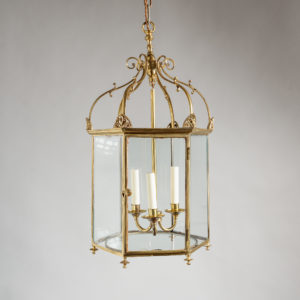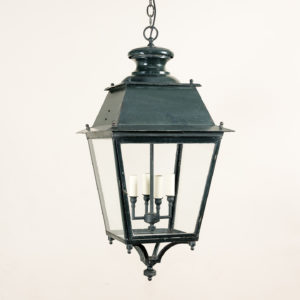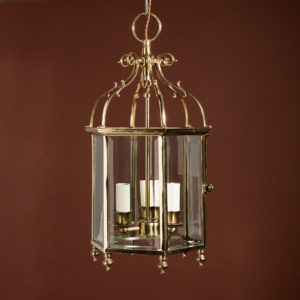No products in the basket.
26 items found
Page 1 of 1
-

A pair of English cast iron and tole peint post-mounted pier-top lanterns
£3,850A pair of English cast iron and tole peint post-mounted pier-top lanterns
each rectangular lantern with a convex sheet steel top and pointed finial, raised on a wrought-iron scrolled chair-iron and baluster-shaped post, with a square foot,£3,850 -

Large cylindrical brass hall lantern,
£3,750Large cylindrical brass hall lantern,
with knopped and scrolled brackets terminating in acorn finials supporting the body, with six-light fitment within. Re-wired and PAT tested.£3,750 -

Large eighteenth century style brass hall lantern,
£3,500Large eighteenth century style brass hall lantern,
with knopped and shaped brackets supporting the bevel glass glazed hexagonal body, with eight light suspended fitment within.£3,500 -

Early nineteenth century style gilt-brass hall lantern
£1,950Early nineteenth century style gilt-brass hall lantern
with scrolled bracket supports and anthemion clasps to each vertex, the three light light fitting suspended within the glazed body. Re-wired and PAT tested.£1,950 -

Victorian verdigris brass hall lantern,
£1,850Victorian verdigris brass hall lantern,
the glazed hexagonal body with heraldic mounts, with single light fitment, retaining the historic on/off chains. Re-wired and PAT tested.£1,850 -

Nineteenth century converted gas lantern,
£1,750Nineteenth century converted gas lantern,
with gothic fretwork banding above and below the tapered body. Now wired for electricity.£1,750 -

Large contemporary lantern
£1,750 -

Early twentieth century hall lantern
£1,750Early twentieth century hall lantern
with well-worn nickel (?) plated finish, with cylindrical etched and cut glass shade surrounding the single light fitment.£1,750 -

French early twentieth century style glazed lantern,
£1,500French early twentieth century style glazed lantern,
of typical form with spun top above tapered body, with four light fitting within, all painted dark green.£1,500 -

Georgian style brass lantern
£1,450Georgian style brass lantern
of hexagonal form with six light internal fitment, re-wired and PAT tested.£1,450 -

Brass hall lantern,
£1,250 -

Brass hall lantern,
£1,250 -

Georgian style brass hall lantern,
£1,250Georgian style brass hall lantern,
of hexagonal form with three light fitment within, re-wired and PAT tested, requires ceiling rose.£1,250 -

Wrought iron lantern,
£1,200 -

Canary Wharf floor lantern
£1,200 -

Early twentieth century brass and cut glass lantern,
£1,150Early twentieth century brass and cut glass lantern,
minor chip to the glass shade - see last photo. Re-wired and PAT tested.£1,150 -

Small brass hall lantern
£950 -

Small brass hall lantern
£950 -

Victorian style brass and iron wall lantern,
£800 eachVictorian style brass and iron wall lantern,
the tapered and glazed hexagonal body with spun finial to the top, on decorative scrolled iron bracket.£800 each -

Pair of French gilt-metal table lamps
£750 the pairPair of French gilt-metal table lamps
late nineteenth century and later converted from altar sticks, re-wired and PAT tested£750 the pair -

Cut glass hallway pendant,
£650 -

Cut glass hallway pendant,
£650 -

Two lanterns
£650 eachTwo lanterns
Having a raised four sided roof leading to stepped frieze above tapered sections with tinted Perspex glazing, shaped finial to base. Slightly different style available, see stock no. 79064 A, last photo shows the two styles together.£650 each -

Two lanterns
£650 eachTwo lanterns
Having a raised four sided roof leading to stepped frieze above tapered sections with tinted Perspex glazing, shaped finial to base. Slightly different style available, see stock no. 79064 B, last photo shows the two styles together.£650 each -

Victorian brass table lamp
£190Victorian brass table lamp
glazed, originally a lantern and later converted to electricity (n.b. will not work if hung).£190
Featured Items
-

Printemps by Marc Chagall, Verve Vol. 1 / No. 3.
£800Printemps by Marc Chagall, Verve Vol. 1 / No. 3.
The Verve Review was a purposefully luxurious. It ran from 1937 to 1960, but with only 38 editions available, due to the high degree of design and editorial work dedicated to each issue. Each edition contained unique lithographic prints, commissioned by the editor, and each cover a double-page lithograph elaborated by one of the artists contained within. It was the brainchild of its editor Stratis Eleftheriades, a Greek National who moved to Paris in the early thirties to take part in the growing Modernist movement, writing under the name of Teriade.£800 -

The Moon by André Masson, Verve Vol. 1 / No. 2.
£600The Moon by André Masson, Verve Vol. 1 / No. 2.
The Verve Review was a purposefully luxurious. It ran from 1937 to 1960, but with only 38 editions available, due to the high degree of design and editorial work dedicated to each issue. Each edition contained unique lithographic prints, commissioned by the editor, and each cover a double-page lithograph elaborated by one of the artists contained within. It was the brainchild of its editor Stratis Eleftheriades, a Greek National who moved to Paris in the early thirties to take part in the growing Modernist movement, writing under the name of Teriade.£600 -

Portrait Fragment by Pierre Bonnard, Verve Vol 2 / No. 5-6.
£600Portrait Fragment by Pierre Bonnard, Verve Vol 2 / No. 5-6.
The Verve Review was a purposefully luxurious. It ran from 1937 to 1960, but with only 38 editions available, due to the high degree of design and editorial work dedicated to each issue. Each edition contained unique lithographic prints, commissioned by the editor, and each cover a double-page lithograph elaborated by one of the artists contained within. It was the brainchild of its editor Stratis Eleftheriades, a Greek National who moved to Paris in the early thirties to take part in the growing Modernist movement, writing under the name of Teriade.£600 -

Autumn by Abraham Rattner, Verve Vol. 1 / No. 3.
£600Autumn by Abraham Rattner, Verve Vol. 1 / No. 3.
The Verve Review was a purposefully luxurious. It ran from 1937 to 1960, but with only 38 editions available, due to the high degree of design and editorial work dedicated to each issue. Each edition contained unique lithographic prints, commissioned by the editor, and each cover a double-page lithograph elaborated by one of the artists contained within. It was the brainchild of its editor Stratis Eleftheriades, a Greek National who moved to Paris in the early thirties to take part in the growing Modernist movement, writing under the name of Teriade.£600

